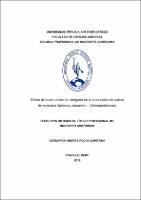Efecto de cuatro dosis de nitrógeno en la producción del cultivo de espinaca Spinacea oleracea L. (Chenopodiaceae)

Ver/
Descargar
(application/pdf: 19.79Kb)
(application/pdf: 19.79Kb)
Fecha
2019Autor(es)
Rojas Quintana, Leonardo Andres
Metadatos
Mostrar el registro completo del ítemResumen
Esta investigación se realizó en las instalaciones de Agroindustrial UPAO
S.A.C., ubicado en Salaverry, Trujillo, La Libertad, de diciembre 2018 a
febrero del 2019. El objetivo fue determinar el comparativo del efecto de
cuatro dosis de nitrógeno en la producción del cultivo de espinaca Spinacea
oleracea L. (Chenopodiaceae). Se realizó mediante el diseño de Bloques
Completamente al Azar con cinco tratamientos y cinco repeticiones. Se
efectuó un análisis de varianza, para determinar las diferencias
significativas y la prueba de significación de Duncan al 0.05 % de
probabilidad, para evaluar el mejor tratamiento. La siembra fue establecida
a un distanciamiento de 0.30 m entre surcos y 0.15 m entre plantas lo que
correspondió a una densidad de plantación de 222,222.00 plantas/ha; el
área utilizada para el experimento fue de 115.5 m 2 . La aplicación de las dosis de fertilizante de nitrógeno (nitrato de amonio) se realizó a los 10, 25 y 40 días después de la siembra. Las dosis del fertilizante de nitrato de amonio fueron de 50, 100, 150 y 200 kg de N/ha; al testigo no se le aplicó
ninguna dosis del fertilizante utilizado. Las evaluaciones de los parámetros
de número de hojas y altura de planta fueron a los 25, 40 y 55 días después
de la siembra. El mayor número de hojas y altura de planta, se obtuvieron
en el tratamiento T3 (100 kg de N/ha), en todas las evaluaciones realizadas,
superando a todos los tratamientos, en especial al tratamiento T1 (Testigo),
el cual no tuvo ninguna aplicación de fertilizante de N (nitrato de amonio).
El mayor rendimiento (t/ha) se obtuvo con el tratamiento 3 (100 kg de N/ha)
con 20.45 t/ha, superando a los demás tratamientos, sobre todo al
tratamiento 1 (Testigo), que ocupó el último lugar con 6.13 t/ha. This research was carried out in the facilities of Agroindustrial UPAO SAC,
located in Salaverry, Trujillo, La Libertad, from December 2018 to February
2019. The objective was to compare the effect of the nitrogen dose on
spinach production Spinacea oleracea L. (Chenopodiaceae). It was done
through the design of Completely Random Blocks with five treatments and
five repetitions. An analysis of variance was performed, to determine the
differences and Duncan's significance test at 0.05% probability, to evaluate
the best treatment. The sowing had a distance of 0.30 m between rows and
0.15 m between plants corresponding to a planting density of 222,222.00
plants / ha; the area for the experiment was 115.5 m2. The application of
the nitrogen fertilizer dose (ammonium nitrate) was carried out 10, 25 and
40 days after sowing. The doses of the fertilizer of ammonium nitrate were
50, 100, 150 and 200 kg of N / ha; No dose of used fertilizer has been
applied. The evaluations of the parameters of number of leaves and the
height of the plant were on days 25, 40 and 55 after sowing. The highest
number of leaves and plant height was obtained in the T3 treatment (100 kg
N / ha), in all the evaluations carried out, surpassing all the treatments,
especially the T1 treatment (Control), which did not have No fertilizer
application of N (ammonium nitrate). The maximum yield (t / ha) was
obtained with treatment 3 (100 kg of N / ha) with 20.45 t / ha, surpassing the
other treatments, especially treatment 1 (Control), which ranked last with
6.13 t / ha
Palabras clave
Colecciones
- Ingeniería Agrónoma [107]

